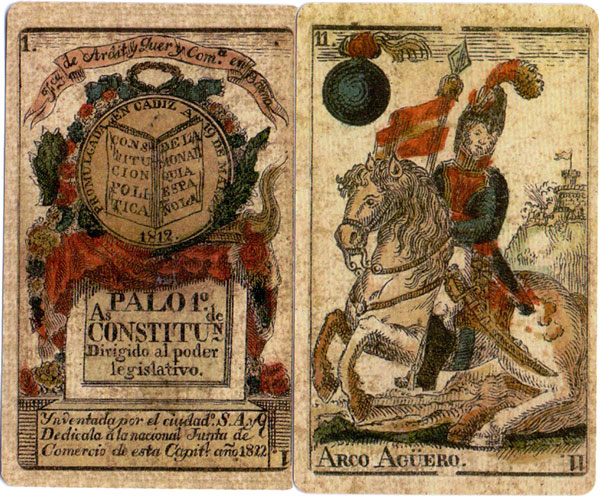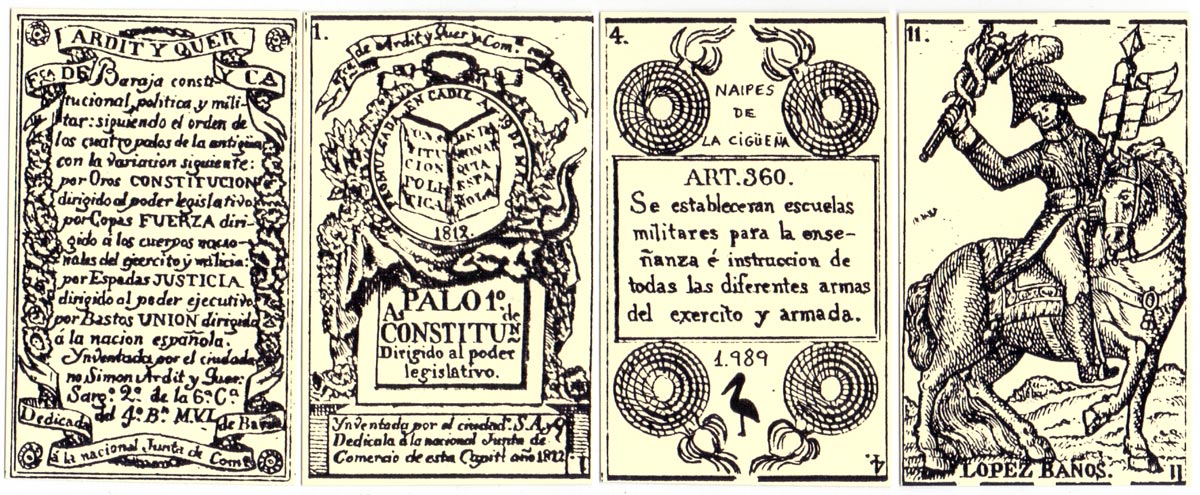La Baraja Constitucional
The “Baraja Constitucional” commemorates the declaration in Cádiz of the Constitution of 1812 and was designed and created by Simón Ardit y Quer in 1822

The historico-political “Baraja Constitucional” commemorates the declaration in Cádiz of the Constitution of 1812 and is dedicated to the Board of Commerce of Barcelona. Packs were accompanied by a propaganda leaflet celebrating the heroic figures depicted on the cards, such as Daoiz, Velarde and Riego, and the events leading to the Constitution. The four suits symbolise the Constitution, Union, Justice and Strength. The coins have been replaced by constitutional texts, the cups by bombs representing strength and the clubs by caducei representing union and commerce. Swords represent justice. The overall symbolism is reinforced by texts on the cards and suggests that through military strength and upholding the law, the constitution, Catholic faith, the monarchy and national rights should all be protected. Several editions were produced, in Barcelona and Madrid, with small differences in details where the outlines were re-drawn or inscriptions modified, until the constitution was abolished by Fernando VII in 1823 and production discontinued.
The “Baraja Constitucional” was designed and created by Simón Ardit y Quer in 1822. It is probably the first Spanish pack of playing cards to be printed using the recently invented method of lithography for the outlines, whilst stencils were used for applying the colours. The outlines were printed lithographically by Viuda e Hijos de D. Antonio Brusi, proprietors of the “Diario de Barcelona” newspaper, and then made up into finished packs by cardmaker Jaime Sandiumenge y Oliver. More recent facsimiles have been published by the Ayuntamiento de Madrid, Ediciones del Prado and Naipes de la Cigüeña.

Above: facsimile edition of “La Baraja Constitucional” published by Naipes de la Cigüeña, Madrid, 1989.
REFERENCES
Agudo Ruiz, Juan de Dios: Los Naipes en España, Diputación Foral de Álava, 2000
Denning, Trevor: The Playing-Cards of Spain, Cygnus Arts, London, 1996
Ferro Torrelles, Victor: “La Baraja Constitucional” (with additional commentary by Alberto Pérez González) in La Sota no.18, Asescoin, Madrid, March 1998.
Bibliothèque nationale de France, “La Baraja Constitucional” • Jeu de cartes à enseignes latines de fantaisie dit de la Monarchie constitutionnelle►

By Simon Wintle
Member since February 01, 1996
I am the founder of The World of Playing Cards (est. 1996), a website dedicated to the history, artistry and cultural significance of playing cards and tarot. Over the years I have researched various areas of the subject, acquired and traded collections and contributed as a committee member of the IPCS and graphics editor of The Playing-Card journal. Having lived in Chile, England, Wales, and now Spain, these experiences have shaped my work and passion for playing cards. Amongst my achievements is producing a limited-edition replica of a 17th-century English pack using woodblocks and stencils—a labour of love. Today, the World of Playing Cards is a global collaborative project, with my son Adam serving as the technical driving force behind its development. His innovative efforts have helped shape the site into the thriving hub it is today. You are warmly invited to become a contributor and share your enthusiasm.
Related Articles

Pierre Varangot
Tracing the origins, legality and legacy of Pierre Varangot’s San Sebastián deck.

Archaic Spanish-suited pattern from Bayonne
Archaic Franco-Spanish pattern from Bayonne by a manufacturer with the initals M.V.

Jeu Révolutionnaire
Court cards and aces from a French Revolutionary pack by Pinaut, Paris, c.1794.

Doppel-Deutsche Karten by Bratří Willnerové, Teplice
This deck from local manufacturer Bratří Willnerová offers a standard version of the popular Central...

French Revolutionary cards by Pinaut
Seven cards from a French Revolutionary pack by Pinaut featuring characters from classical antiquity...

Zürcher Festspiel 1903
Swiss-suited pack designed by Robert Hardmeyer featuring figures from art and politics.

Tarot de las Coscojas
Historical playing card design, tarot symbolism and an almost psychedelic medieval surrealism.

Tarot de Valverde de la Vera
A series of 24 surrealist engravings by Mexican artist Claudio Favier in which archetypal Tarot alle...

Baraja de Juan Martín Zamorano
Deck inspired by El Pendón de los Zamorano, a military pennant dating from 1501, published by Priego...

Heráldica Castanyer No. 16
Strange variant of international pattern cards for poker or bridge.

Fantasy Spanish-suited deck
Fantasy Spanish-suited deck by Bertschinger y Codina, Barcelona.

Bertschinger y Codina - Cartes Françaises
French ‘Paris’ pattern made by Bertschinger y Codina, Barcelona, c.1850.

Braulio Fournier
Baraja Nº 1 produced by Braulio Fournier, Burgos, c.1868.

Pirritx eta Porrotx
Happy Families card game from the Spanish Basque Country.

Naipe Vizcaino
‘Naipe Vizcaino’ designed by Javier Urkiri and published by Industrias Gráficas Castuera and the Caj...

Baraja Turística del País Vasco
Basque poker deck of 55 cards published by Fournier with scenic views of the Basque Country.
Most Popular
Our top articles from the past 28 days









